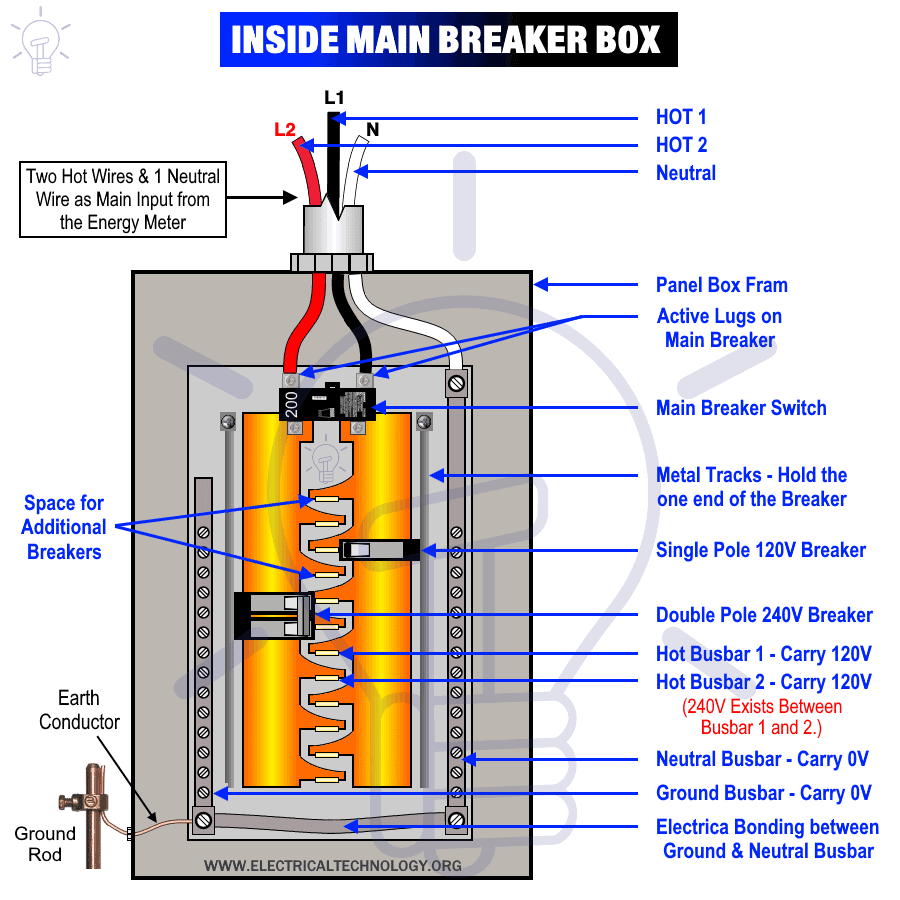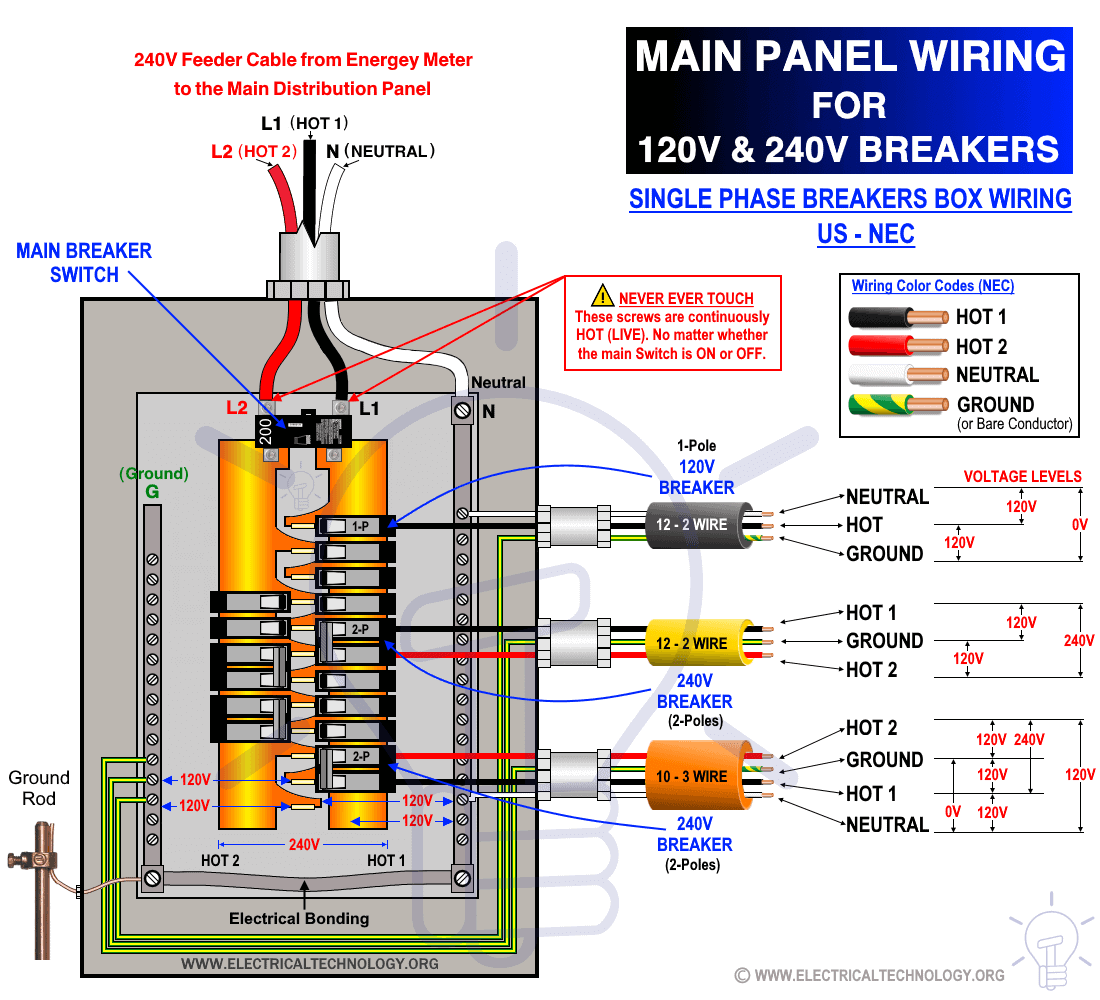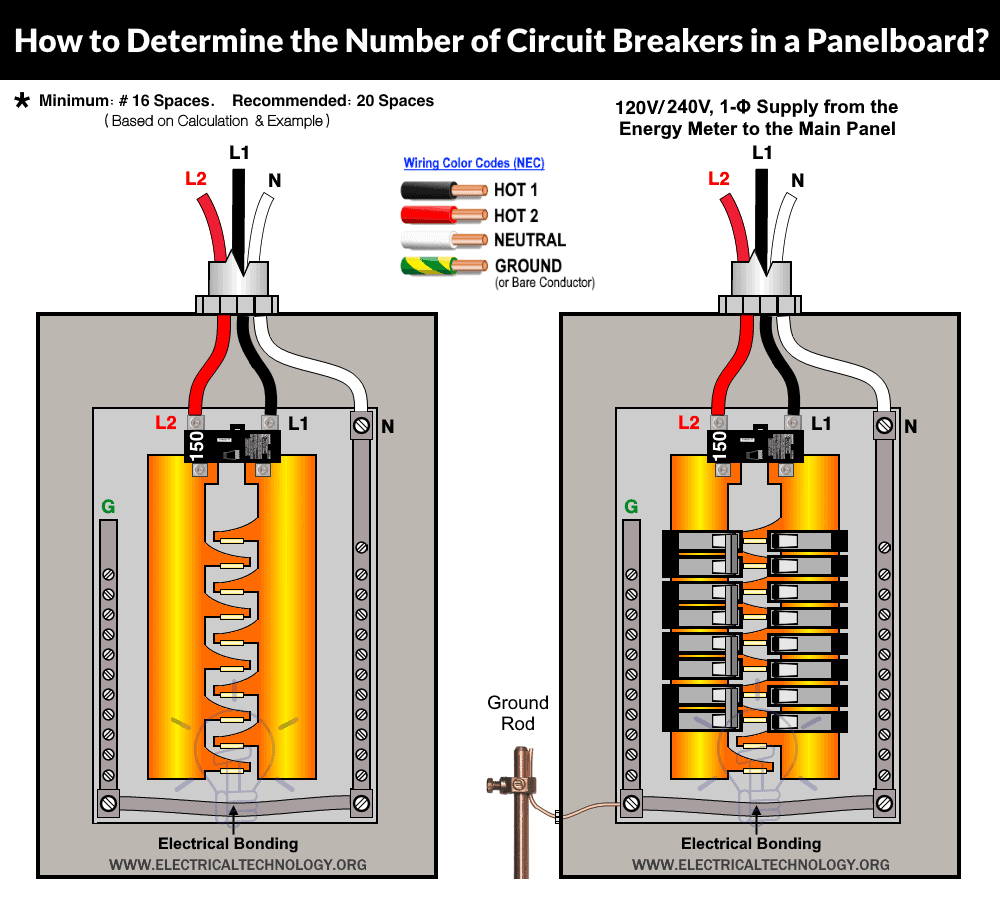How to Determine the Number of Circuit Breakers in a Panel Board?
How to Calculate the Number of Circuit Breakers for a Home Load Center and Distribution Board Based on the Load Calculation?
In the USA and Canada, the common supply voltage to the residential buildings and homes is 120V & 240V based on the NEC and CEC. This single phase supply (actually a split phase system) has three wires (Hot 1, Hot 2 and a Neutral) from the distribution transformer to the meter box and main service panel i.e. main switch breaker. Recalling this basic information is necessary to determine the exact number of breakers required in a panel board, load center, or distribution board.
The available voltage levels in a single phase 120V/240V load center and panel box installed in the home are as follow:
- Voltage between Hot 1 (any one of Black or Red) and Neutral (White) = 120V Single Phase
- Voltage between Hot 1 (Black) and Hot 2 (Red) = 240V Single Phase (Split phase voltage)
- Voltage between Neutral (White) and Ground (Green or Bare Conductor) = 0V.
Note: The NEC wiring color codes are used for the above statement.
Click image to enlarge
The following figure shows the basic configuration of 120V/240V single phase supply connected to a 24 breaker space or load circuits in the load center, breaker box or panelboard. This also shows that 120V single phase is available between Black and White (any of Hot 1 or Hot 2) and White (Neutral) while the 240V split phase is available via Black & Red (Hot 1 & Hot 2). The required number of wires and cables depends on the load circuit and device configuration i.e. some of the 240V circuit doesn’t need a Neutral wire while others do.
In a load center, a 120V single pole circuit breaker occupies a single position while a 240V double pole breaker acquires two positions in the load center.
Related Posts:
- How to Size a Load Center, Panelboards and Distribution Board?
- How to Determine the Number of Circuit Breakers in a Panelboard?
Click image to enlarge
Determining the Number of Breakers / Circuits in the Panelboard
Note 1: The following example is based on VA (Volt x Amperes) which is known as apparent power. You may use the active or real power (in Watts) which is equal to Apparent power x power factor or VA x PF as power factor in residential buildings are almost unity (1). In this case, the apparent power in VA is equal to real power in W “Watts”.
Note 2: It is recommended to check the previous example for sizing a load center and distribution board as we have used the same terminology for this example.
Related Posts:
- How to Size a Load Center, Panelboard and Distribution Board?
- How to Find the Proper Size of Circuit Breaker? Breaker Calculator & Examples
Example:
Determine the suitable number of breakers and circuits in a load center or distribution board for an 1500 ft2 (139.35 m2) home floor plan having the following load circuits: Consider the power factor to be unity “1”.
- General lighting = 4.5 kVA
- Air conditioner = 6 kVA
- Electric range = 8.4 kVA
- Electric heater = 7.2 kVA
- Clothes dryer = 3.6 kVA
- Dishwasher = 1.2 kVA
- Garbage disposal = 0.96 kVA
- Two Small appliances circuits in the kitchen for refrigerator, blinder, etc.
- 20% expansion & Future load etc.
Solution:
General Lighting Circuits:
Lighting circuits are generally 120V having 15A or 20A. To find the number of breakers and space in the load center, we have to calculate the load current by using the basic power formula as follows:
I = P / V
Where:
Putting the values:
I = 4500 VA / 120V
I = 37.5 A
These are the total amperage needed for the lighting circuits. Either 15A or 20A circuit breaker can be used with proper sized wire and suitable switches & plugs. Mostly, 15A breakers are used for the lighting points, this way, we will divide the total lighting amperes by 15A to determine the number of lighting circuits.
37.5 A / 15A = 2.5A (rounded up to 3).
It means, we will use 3 numbers of lighting circuit breakers.
Small Appliances
In the given example, there are two small appliances load circuits i.e. 2 Nos of 120V, 20A circuit breaker.
Laundry Circuits
There is only 1 number of 20A, 120V circuits needed for a clothes washer in the given example.
Large Appliances circuits:
We mean the large appliances which operated on two poles 240V circuit breakers. All the air-conditioner, electric range/stove, electric heater, clothes dryer etc. are operated on 240V circuit and hence considered individually. Keep in mind that the 240V double pole breaker occupies two spaces (position) in the breaker box. Now let’s find the required number of circuit breakers in the load center (based on Amps) for large appliances by dividing the kVA rating of the device by 240V.
Air conditioner
Using the basic current formula as above
I = P / V
I = 6 kVA / 240V
I = 25A.
Generally, the ampere rating of a circuit breaker should be selected at 125% (factor of 1.25) for the continuous load i.e. electric heaters and air conditioner etc. In case of air-conditioner,
125% x 25A = 31.25 A.
This way, the next and nearest available circuit breaker like 35A should be used for a 6kVA air-conditioner. Keep in mind the same (125%) is applicable to the wire size i.e. both 35A wire and circuit breaker should be used for 31.25 Amp load specified for Air-conditioner any other continuous and simultaneous load.
Electric Heater Circuit
Same like above calculation, the amps rating of the 7.2 kVA electric heater is as follow:
I = 7.2 kVA / 240V = 30A
Multiplying the safety factor of 125%.
1.25 x 30A = 37.5 A
As the ampacity of the circuit breaker should not exceed the current rating of the conductor used for it. A 40A breaker along a 40A wire size (the next & nearest standard size) must be used for an electric heater circuit rated for 7200 VA.
Electric Range Circuit:
Using the above method of basic calculations, It is a 35A, 240V circuit (8.4 kVA / 240V). Now with safety factor
1.25 x 35A = 43.75A
The next and nearest available & recommended size of circuit breaker and wire size is 50A for 8400VA, 240V electric stove.
Clothes Dryer Circuit
The clothes dryer is 15A, 240V (3.6kVA / 240V). Multiplying the safety factor:
125% x 15A = 18.75A
The recommended wire size and circuit breaker is 20A, 240V double pole.
Garbage Disposal Circuit
Bothe garbage disposal and dishwasher are 120V circuits. The garbage disposal is 10A, 120V circuit (1.2kVA / 120V). With safety factor:
125% x 10A = 12.5A
The next available & suitable wire size and circuit breaker is 15A, 120V single pole.
Dishwasher Circuit
The dishwasher is 8A, 120V circuit (0.96kVA / 120V). With safety factor:
125% x 8A = 10A.
The proper size of single pole, 120V, 10A circuit breaker is needed with the same wire size.
Related Posts:
- How to Determine the Right Size Capacity of a Subpanel?
- How to Find the Right Wire Size for 100 Amp in AWG?
- How to Wire a Subpanel? Main Lug Installation for 120V/240V
Total Number of Spaces for Circuit Breakers in the Breaker Box:
Now, we may calculate the total number of required spaces for circuit breakers in the load center as shown in the table below.
| Circuit | Qty | Circuit Breaker | Voltage | Space Required |
| General Lighting | 3 | 15A | 120V | 3 |
| Small Appliances | 2 | 20A | 120V | 2 |
| Laundry | 1 | 20A | 120V | 1 |
| Air conditioner | 1 | 35A | 240V | 2 |
| Electric Heater | 1 | 40A | 240V | 2 |
| Electric Range | 1 | 50A | 240V | 2 |
| Clothes Dryer | 1 | 20 | 240V | 2 |
| Garbage Disposal | 1 | 15 | 120V | 1 |
| Dishwasher | 1 | 10 | 120V | 1 |
| 16 | ||||
Based on the calculation for the above example, a minimum of 16 spaces of load center is required. Due to the future expansion and 20% extra load points, a 20-space panel box is the suitable option to be on the safe side as shown in the following figure.
Click image to enlarge
Following are more related resources and step by step guide tutorials with solved examples:
- How to Wire 120V & 240V Main Panel? Breaker Box Installation
- How to Wire 277V & 480V, 1-Phase & 3-Phase, Commercial Main Service Panel?
- How to Find The Suitable Size of Cable & Wire ? – Solved Examples
- What is the Right Wire Size for a 4.8kW, 240V Range: #10 or #12?
- How to Find Voltage & Ampere Rating of Switch, Plug, Outlet & Receptacle
- How to Read MCB Nameplate Data Rating Printed on it?
- How to Wire a Single Element Water Heater and Thermostat?
- How to Find the Size of Earth Conductor, Earthing Lead & Earth Electrodes?
- Wire & Cable Size Calculator in AWG
- Electrical Wire & Cable Size Calculator (Copper & Aluminum)
- How to Wire Single-Phase, 230V Consumer Unit with RCD? IEC, UK & EU
- How to Wire a Garage Consumer Unit?
- How to Wire 1-Phase Split Load Consumer Unit? – RCD+RCBO
- How to Wire 230V Dual Split Load Consumer Unit? – RCD+MCB










Thanks for your article.
One minor typo that I wanted to bring to your attention to that could be confusing for future readers.
“Laundry Circuits
There is only 1 number of 20A, 120V circuits needed for a clothes dryer in the given example.”
In this sentence, I believe you intended to say Clothes washer ( Not Dryer ). Dryer is describes later under 240v circuits.
Thanks for correction.
Hi
Thanks for the article. There is a mistake in the beginning of the article. When describing voltage between wires.
Your statement
“Voltage between Neutral (Black) and Ground (Green or Bare Conductor) = 0V.”
This Should read
Voltage between Neutral (White) and ground (Green or Bare Conductor) = 0 Volts.
Neutral (Black) is incorrect
Thanks
Erik
Hi Erik,
The typo was modified. Thanks for the correction.